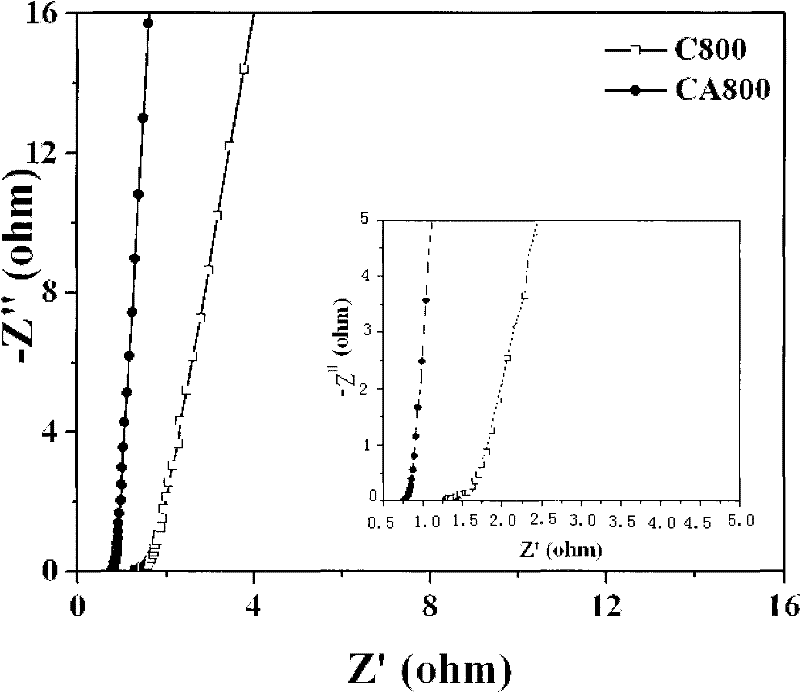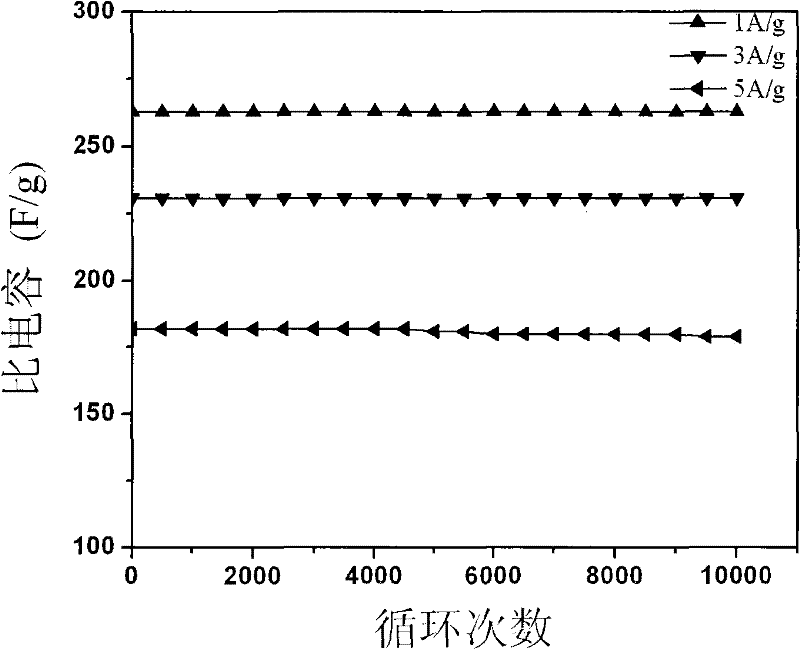Active carbon-based material and preparation method thereof
A base material, activated carbon technology, used in electrical components, electrolytic capacitors, battery electrodes, etc., can solve the problems of low energy density and power density of supercapacitors, limited space for increased specific surface area, and decreased volume specific capacity, etc. Thermal and electrical conductivity, high energy density and power density, effect of low density
- Summary
- Abstract
- Description
- Claims
- Application Information
AI Technical Summary
Problems solved by technology
Method used
Image
Examples
Embodiment 1
[0021] (1) Dissolve 1.86mL aniline (AN) in 25mLH 2 SO 4 1.14g ammonium persulfate (APS) was dissolved in 50mL distilled water or deionized water to form solution B ([APS] / [AN]=1:4); (2) transfer solution A into the reaction flask Inside, add B dropwise to the reaction bottle under stirring, after the drop is completed, react at room temperature for 4 hours; (3) collect the product in the reaction bottle, wash the product with water, ethanol or acetone for several times, until the washing liquid is neutral; (4) The washed product was vacuum-dried at 60°C for 48h to obtain polyaniline doped with sulfuric acid; (5) in an inert gas N 2 Carbonize polyaniline at 800°C for 2h under protection; (6) Activate the above-prepared carbonized material in water vapor at 200°C for 2h at a constant temperature, and cool to room temperature to obtain N, O, S atom-doped activated carbon-based Material. Through elemental analysis and X-ray photoelectron spectroscopy (XPS) testing, the componen...
Embodiment 2
[0024] (1) Dissolve 1.86mL aniline in 25mLH 2 SO 4 2.28g ammonium persulfate was dissolved in 50mL distilled water or deionized water to form solution B ([APS] / [AN]=1:2); (2) put solution A and solution B in the reaction flask After rapid mixing and stirring for 1 min, it was allowed to stand at room temperature for 10 h; (3) collect the product in the reaction bottle, and wash the product repeatedly with water, ethanol or acetone until the washing liquid is neutral; (4) wash the product Dry in vacuum at 60°C for 48h to obtain doped polyaniline; (5) in an inert gas N 2 Carbonize polyaniline at 800°C for 2h under protection; -1 Soak in nitric acid solution for 24 hours for activation treatment, then wash with water, dry, and ball mill to obtain activated carbon material. The code of the unactivated sample prepared in this embodiment is C800, and the code of the activated sample is CA800.
[0025] The electrode fabrication, supercapacitor assembly, and testing equipment in t...
Embodiment 3
[0027] (1) 20mmol of aniline and 20mmol of HAc were ultrasonically mixed for about 2 minutes to obtain A; (2) 25mmol of APS was dissolved in 20mmol of HAc, ultrasonically dissolved and mixed for about 2min to obtain B. (3) A and B were ultrasonically mixed for about 2 minutes at room temperature, and then left to react at room temperature for 8 hours. (3) collect the reaction product, wash the product with water until the washing solution is neutral; (4) dry the washed product in vacuum at 60°C for 24h to obtain doped polyaniline; (5) in an inert gas N 2 Carbonize polyaniline at 800°C for 4h under protection; (6) After mixing the carbonized material prepared above and sodium hydroxide evenly, activate it at 700°C for 2h under nitrogen protection (the mass ratio of carbon to NaOH is 2:1), After washing with water, drying and ball milling, the activated carbon-based material can be obtained.
[0028] The electrode fabrication, supercapacitor assembly, and testing equipment in t...
PUM
| Property | Measurement | Unit |
|---|---|---|
| current density | aaaaa | aaaaa |
Abstract
Description
Claims
Application Information
 Login to View More
Login to View More - R&D
- Intellectual Property
- Life Sciences
- Materials
- Tech Scout
- Unparalleled Data Quality
- Higher Quality Content
- 60% Fewer Hallucinations
Browse by: Latest US Patents, China's latest patents, Technical Efficacy Thesaurus, Application Domain, Technology Topic, Popular Technical Reports.
© 2025 PatSnap. All rights reserved.Legal|Privacy policy|Modern Slavery Act Transparency Statement|Sitemap|About US| Contact US: help@patsnap.com



